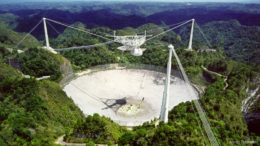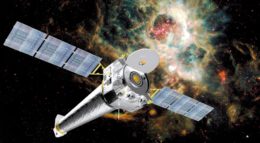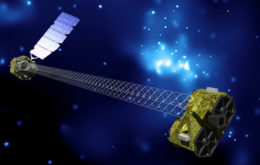Editor’s Note: This week we’re at the virtual 238th AAS Meeting. Along with a team of authors from Astrobites, we will be writing updates on selected events at the meeting and posting each day. Follow along here or at astrobites.com. The usual posting schedule for AAS Nova will resume on June 14th.
SPD George Elery Hale Prize Lecture: The Evolution of Our Understanding of Coronal Mass Ejections (by Tarini Konchady)

A CME as seen by Skylab’s coronagraph on August 10, 1973. The CME is on the right side of the image.
This year’s recipient of the Hale Prize is Russell Howard (Naval Research Laboratory), for “his influential contributions to the discovery, measurement, and physical understanding of coronal mass ejections and their role in space weather, and for his outstanding leadership in the development, deployment, and management of innovative space instrumentation to image the solar corona and inner heliosphere”. Quite aptly, Howard’s talk was titled “The Evolution of Our Understanding of Coronal Mass Ejections”.
Coronal mass ejections (CMEs) are the expulsion of plasma and the associated magnetic fields from near the Sun’s surface. They are extremely fast, and a single CME could cause catastrophic damage if it hit the Earth. However, our study of CMEs started fairly recently. In fact, Howard joined the Naval Research Laboratory only three months before the first observations of a CME, which was in 1971. And even then, “coronal mass ejection” didn’t enter the vocabulary of solar physics till the 1980s.
Howard outlined the history of CME science in the context of the various solar instruments that have been used to study CMEs. The first generation of instruments were on the Orbiting Solar Observatory 7 (OSO-7) and the space station Skylab. OSO-7 gave us the first observation of a CME, while Skylab produced a large sample of CME observations that would create the archetype of the event. The next generation of instruments was on the Solar Maximum Mission (SMM) and Solwind, also known as P78-1. The observations taken by the instruments on these missions let us study the evolution of CMEs more closely and identify correlations between CMEs and properties like X-ray emission and sunspot occurrence.

The three generations of solar instruments/missions that have been used to study CMEs. [Russell Howard]
We’re still in the third generation of solar instruments and there still remain many questions to be answered. For instance, how do CMEs travel through space and how could they impact the Earth? What instabilities in the Sun create CMEs? With this latest set of instruments, the answers could arrive sooner than we think!
Live-tweeting of the session by Tarini Konchady
Press Conference: Fast Radio Bursts / Exoplanets & Brown Dwarfs (by Sabina Sagynbayeva)
The first press conference of Day 3 was emceed by none other than astrobites author Luna Zagorac, who is serving as the Astrobites Media Intern for AAS 238. Luna introduced panelists presenting on two very different topics: fast radio bursts (FRBs), and exoplanets/brown dwarfs.
Kiyoshi Masui (MIT) started off the discussion with “Fast Radio Bursts: From a Handful to Hundreds with CHIME/FRB.” The first FRB — a mysterious and brief flash of radio light usually stemming from outside our galaxy — was discovered in 2007; since then, 535 FRBs have been observed and put into the The Canadian Hydrogen Intensity Mapping Experiment (CHIME) catalog! CHIME has opened a new phase of FRB science, enabling precision studies of the FRB population and an opportunity to study large-scale structure of the universe. Following the discussion, Alex Josephy (McGill University) talked about population modelling. His group works on understanding observational biases by simulating fake bursts and analyzing observational factors like sensitivity, telescope response, and the galactic foreground. After correcting for these effects, they found strong evidence of a uniform FRB distribution. Finally, Mohit Bhardwaj (McGill University) talked about FRB20181030A, a repeating FRB in the CHIME/FRB catalog. This FRB is localized to a sky area ~140x smaller than the Moon in the sky! Press release
Jacob Nibauer (University of Pennsylvania) next pivoted to planets with “A Statistical Search for Chemical Signatures of Planet Formation in Sun-like Stars.” Thus far, we’ve primarily identified exoplanets by examining a star’s radial velocity, and by looking for transits. But we can also look at the chemical composition of the star! If rocky planets were formed in circumstellar disks around the star, then the star might have less refractory material (rocky material) than the star without planets (in this case all the refractory material will be eaten by the star). Nibauer and collaborators used data from APOGEE-2 to examine 1,500 Milky Way stars and categorize them as “depleted” or “not depleted” of refractory material. In so doing, they showed that our own Sun is a member of a majority population (>60%) of depleted stars — not far off from the estimated fraction of stars with rocky planets. These two populations may therefore be related to the presence/absence of rocky planets. Press release

Artist’s impression showing the relative sizes and colors of the Sun, a red dwarf (M-dwarf), a hotter brown dwarf (L-dwarf), a cool brown dwarf (T-dwarf), and the planet Jupiter [Credit: NASA/IPAC/R. Hurt (SSC)]
YouTube recording of the session on the AAS Press Office channel
Live-tweeting of the session by Sabina Sagynbayeva
SPD Agency Town Hall (by Luna Zagorac)
The Solar Physics Division (SPD) Agency Town Hall began with updates from the National Science Foundation (NSF), courtesy of Carrie Black. Black encouraged folks to submit solar physics proposals to the Astronomical Sciences (AST) division of NSF as the division is proposal-driven: this means that increasing numbers of solar proposals will result in increased funding for solar physics research! Now would be a particularly good time to submit any solar eclipse proposals. Black also plugged NSF’s Astronomy and Astrophysics Postdoctoral Fellowships as an opportunity to fund solar research. She also noted that it’s been a tough year for AST between COVID impacts and absorbing most of the Arecibo cleanup costs. However, there are also new programs within AST to help severely impacted groups, including people who are at transition points in their careers. Black concluded by looking forward to decadal surveys, including Astro2020 this summer and the Solar and Space Physics (SSP) decadal.Next, Nicola Fox of NASA’s heliophysics division announced that the division is experiencing incredible growth. She also thanked everyone who participated in the Helio 2050 Workshop held in early May 2021, and encouraged everyone to keep the discussion sparked there going into the next decadal. She further noted that IDEA initiatives are being recognized as a long-term effort, but immediate action and problems are considered and incentivized as well. Finally, she reminded everyone that they can stay informed through her monthly “Nicky Notes” from (sign up here), as well as by checking the NASA Town Hall website.
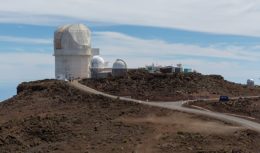
The Daniel K. Inouye Solar Telescope is scheduled to conclude construction this year. [Ekrem Canli]
Finally, Holly Gilbert updated us on the High-Altitude Observatory (HAO), the solar-terrestrial research laboratory of the National Center for Atmospheric Research (NCAR). The research program of HAO is broad, spanning from the origins of magnetism in the Sun to the upper edge of the terrestrial stratosphere. HAO runs several cutting-edge instruments, including the COSMO K-Coronagraph (K-COR) on the Mauna Loa Solar Observatory (MLSO), as well as COMP, the coronal multi-channel polarimeter. These instruments are designed to carry out synoptic large-scale observations of the Sun’s magnetic activity. COMP was used, for the first time, to map the global coronal magnetic field of the Sun! These, along with upcoming instruments (e.g, ChroMag & the Large Coronagraph) will hopefully expand our understanding of solar magnetic fields. Finally, Gilbert noted that the next NCAR/HAO workshop will take place Sept 12–17, 2021; stay tuned here.
Live-tweeting by Luna Zagorac
Astro2020 Advocacy, Satellite Constellations, and More! Town Hall (by Macy Huston)
The AAS Policy Town Hall covered current issues in science and space policy. Megan Donahue began with an introduction to CAPP (the Committee on Astronomy and Public Policy), which supports and develops policies that advance the astronomical sciences in the United States. They are involved in the Decadal Survey process, in which the astronomy community reviews the state of the science and makes recommendations for relevant funding agencies. CAPP’s advocacy plans include coordinating a task force and arranging communications between survey leaders and government members and agencies.
The pandemic-related delays in the Decadal Survey have pushed back budget planning. The FY22 and 23 budgets had to be created without the report, but it will be incorporated in FY24 plans. AAS/CAPP will release a statement about the report, encouraging the community to avoid in-fighting, analyzing timelines and budgets, and supplying talking points for those who communicate with policymakers. The NSF has received a funding increase of 20% in the president’s FY 2022 budget request, and NASA received a bump as well. CAPP aims to get specific mentions of astronomical priorities in relevant bills and agency plans.

A long-exposure image of the Orion Nebula showing Starlink satellite trails in mid-December 2019, a month after the second Starlink launch. The upcoming SATCON2 workshop will convene the community to discuss how to minimize the impact of satellite constellations on astronomy. [A. H. Abolfath]
The UN Office of Outer Space Affairs (UNOOSA) and the International Astronomical Union (IAU) are working on international policies and collaborations to address these issues. The AAS has made a case for studying the science impacts of space debris, and the FCC recently stated that these science impacts should be considered in their rulings. Modelling is currently in progress to determine under what circumstance a space debris runaway (a progressive series of collisions in orbit that produce exponentially increasing debris) could occur, devastating prospects for astronomy and spaceflight. The SATCON2 Workshop (July 12–16) will work to address the problem of satellite constellations. In addition to these issues, Artificial Light At Night (ALAN) on Earth’s surface remains a long term threat to ground-based observatories. The IAU and UNOOSA are planning a workshop on Dark and Quiet Skies for the Fall of 2021.
Plenary Lecture: The Complex Upper H-R Diagram – Shaped by Mass-Loss (by Ellis Avallone)

A qualitative HR diagram showing where different types of stars live. The colors are roughly true to life. Temperature is given on the x-axis with luminous or brightness on the y-axis. [ESO]
Back in the 1970s, Dr. Humphreys and her colleagues noticed that massive stars had a linear upper limit on their brightness. This was the first clue that mass loss, specifically extreme mass loss events, were taking place as massive stars moved into the late stages of their evolution. When the 1990s rolled around and Hubble was launched, we were able to get incredibly detailed observations of mass loss in evolved massive stars!
Dr. Humphreys moved on to describe a fan favorite example of stellar mass loss, the red hypergiant VY CMa, which she dedicated to the late Dr. George Wallerstein, founder of the University of Washington Astronomy Department and VY CMa enthusiast. VY CMa is an incredibly well-observed star, with lightcurve observations going back to the 1800s! Thanks to a combination of observations from Keck, Hubble, and ALMA, we now know that gaseous outflows both account for and explain the mass loss experienced by this star. These gaseous outflows are likely shaped and supported by magnetic fields.
Many stars in this regime are also pulsationally unstable, exhibiting periodic variability both in their lightcurves and spectra. Luminous Blue Variables (LBVs) are one such class of star that exist in super close proximity to the Eddington limit, the theoretical upper limit on a star’s luminosity. It’s thought that the mass loss events experienced by these stars are triggered when they exceed the Eddington limit and become unstable.
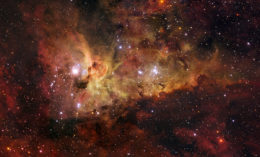
The Carina Nebula, as seen by the 1.5-m Danish telescope at ESO’s La Silla Observatory. Eta Carinae is the brightest star in the image. [ESO/IDA/Danish 1.5 m/R.Gendler, J-E. Ovaldsen, C. Thöne, and C. Feron]
Interview of Roberta Humphreys by Sabina Sagynbayeva
Live-tweeting of the session by Ellis Avallone
LAD Early Career Award: From Atoms To Black Holes: Modeling Dense Astrophysical Plasmas (by Sabina Sagynbayeva)
Javier García (Caltech) is the 2021 recipient of the Laboratory Astrophysics Division’s Early Career Award. García’s career has spanned a broad range of contributions to computational atomic physics and high-energy photoionization/spectral modeling. Accordingly, his plenary touched on the variety of ways we can model dense astrophysical plasmas.
Background X-ray sources are valuable means to characterize absorbing material in the line of sight, García mentions, but this process relies on a thorough understanding of the atomic physics at work! By cross-comparing theoretical calculations of absorption lines, data from laboratory experiments, and actual observations from X-ray observatories like Chandra and XMM-Newton, scientists are able to perform benchmarking to make sure the right parameters are used in the models and the instruments are calibrated correctly.Another way we can use X-ray atomic lines is via reflection spectroscopy. By exploring the reflected X-ray spectra from accreting black holes, we can obtain estimates of their spins — if we have a good model! Future work in this field will rely both on increasingly better data — e.g., from Athena, a future X-ray observatory — and on improving the atomic physics included in the models. In accretion-disk microphysics, typical reflection models are calculated for low densities, but to accurately model the plasma environment around a black-hole binary or an active galactic nucleus, we also need to account for high-density plasma effects.
García concludes that X-ray reflection spectroscopy provides the best means to estimate black-hole spin, among many other parameters. Astrophysical observations give access to the best laboratories in the universe that can be used to calibrate models and learn about atomic structure. While the future is X-ray bright (with new observatories like XRISM, IXPE, Athena, and eXTP planned), we need to be prepared. Lab Astro will play a fundamental role!
Live-tweeting of the session by Sabina Sagynbayeva
Press Conference: Exoplanets & Brown Dwarfs (by Susanna Kohler)
The final press conference of the meeting supplemented the previous briefing with even more presentations on exoplanets and brown dwarfs.
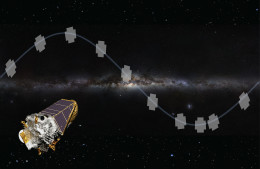
Artist’s illustration of Kepler and its fields of view across the galaxy during the K2 mission. [NASA]
So far, the majority of the 889 planet candidates discovered in K2 data have resulted from visual inspection due to the noisy data. But Jon Zink (University of California, Los Angeles) reported on 372 brand new planet candidates recently produced by an automated detection pipeline. This large dataset — produced in a uniform way and spanning a large area on the sky — is perfect for exploring population statistics.
Sakhee Bhure (Florida Institute of Technology) then talked about the next step: validating these candidates. To become a confirmed planet, a candidate must have its mass measured — a challenging process. But there’s another way to establish the legitimacy of a candidate: we can statistically validate it by calculating the likelihood that the transit shape in its light curve is produced by a true planet rather than by some other source. Bhure presented VESPA, a tool developed by Dr. Timothy Morton that performs this analysis and assigns a likelihood to a candidate’s legitimacy. She then walked us through a few of the 21 planets that VESPA has newly validated.

Illustration of the cloud layers of a brown dwarf based on the observations obtained by Manjavacas and collaborators. Click to enlarge. [NASA, ESA, STScI, Andi James (STScI)]
Concluding the session, Jason Curtis (Columbia University) told us the story of how two seemingly old and unrelated exoplanet systems turned out to be rather young siblings. Kepler 52 and Kepler 968 are two stars — each hosting three planets — that were thought to be isolated and old, with ages estimated at 3–16 billion years (that huge range should tell you how hard it is to measure stellar ages!). New work by Curtis and collaborators has now shown that these two systems are actually both part of the same newly discovered cluster of stars called Theia 520. By exploring the rotation rates of the stars, the team was able to associate these stars with one another and age the cluster at just ~350 million years old. Press release (PDF)
YouTube recording of the session on the AAS Press Office channel
Astrobites Webinar (by Macy Huston)
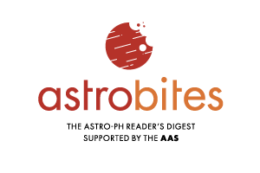 We had our Astrobites webinar today, in which panelists Luna Zagorac, Mia de los Reyes, and Sabina Sagynbayeva introduced who we are and how people can get involved. Astrobites is the astro-ph “Reader’s Digest.” We are supported by the AAS and share daily “bite-sized” paper summaries accessible to undergraduate astronomy students. We are an international collaboration of graduate students, with 41 authors currently, typically on 2-year rotations.
We had our Astrobites webinar today, in which panelists Luna Zagorac, Mia de los Reyes, and Sabina Sagynbayeva introduced who we are and how people can get involved. Astrobites is the astro-ph “Reader’s Digest.” We are supported by the AAS and share daily “bite-sized” paper summaries accessible to undergraduate astronomy students. We are an international collaboration of graduate students, with 41 authors currently, typically on 2-year rotations.
Our bites generally contain background on the covered paper’s topic, a summary of its results, and relevant figures. We try to avoid jargon (or we provide links to more info when we have to use it), and the summaries are typically between 600–1000 words. In addition to paper summaries, we also write “Beyond” posts, which cover topics like diversity, equity, and inclusion, day-to-day work advice, current event coverage (like this!), and career/application advice.
So how can you get involved? Undergraduates are invited to submit their research to be published on our site. Graduate students can apply to be an Astrobites author; we accept applications every year, typically due in November. Graduates students (as well as others, e.g., post-bac researchers) are invited to submit a guest post. Educators are invited to use Astrobites for reading assignments, source material, or writing assignment examples. We also have a paper about using Astrobites in the classroom, which includes free lesson plans. Also, check out our sister sites for Astrobites in a few languages besides English: Astrobitos (Spanish), Astropontos (Portuguese), staryab (Farsi), and ArAStrobites (Arabic).
Lastly, our panelists answered some questions, both pre-prepared and sourced from the audience. What they love about being a part of Astrobites is the supportive and collaborative community, as well as the networking opportunities it provides. Asked about our collaboration structure, we clarified the non-hierarchical organization. We are a group of writers who peer-edit on a rotating schedule. AAS sponsors us, but they don’t have editorial control over our work. We have a set of committees made up of members who opt to take part in them, for example the Diversity, Equity, and Inclusion Committee and the Scheduling Committee. Our panelists wanted to join astrobites because of past experiences with finding the paper summaries helpful and enjoying writing a guest post. A few things they would like to see in the future of Astrobites are more collaboration with our sister sites to translate posts, expansion of the Black in Astro series, gaining more international participation beyond the US and Europe, and including more languages.
Live-tweeting of the session by Macy Huston
Plenary Lecture: Science Highlights from the Nuclear Spectroscopic Telescope Array (NuSTAR) (by Luna Zagorac)
The last plenary of AAS238 was delivered by Daniel Stern (NASA JPL). Stern spoke about science highlights from the Nuclear Spectroscopic Telescope Array (NuSTAR) — a NASA Small Explorer mission that launched 9 years ago, during the last AAS meeting scheduled in Anchorage, AK. NuSTAR is an X-ray telescope that observes high energies comparable to ones used in doctors’ and dentists’ instruments. It is also the first focusing X-ray satellite, meaning that the images it produces are sharper and have lower background levels than its predecessors.Three key technologies enabled NuSTAR: a cadmium-zinc-tellurium detector, a deployable mast (which allowed NuSTAR to launch on a smaller rocket and then unfurl once in orbit!), and hard-X-ray optics.Stern went on to discuss some of the big scientific results that have come about from this relatively small instrument. The first breakthrough had to do with ultraluminous X-ray sources (ULXs), a class of objects whose identity has been a mystery since the first ULX was detected by the Einstein Observatory in the ‘80s. Since most X-rays come from the accretion of material onto black holes, ULXs were posited to be either (very rare) intermediate-mass black holes feeding at typical rates, or stellar-mass black holes feeding at prodigious rates. NuSTAR somewhat unwittingly contributed to the unveiling of ULXs while observing supernova SN2014J: it also observed two ULXs at the center of the galaxy M82 in the field of view. Interestingly, one of these ULXs was also pulsating at the time — which is something black holes just do not do. Thus, the source of this ULX, at least, was revealed to be not a black hole but an ultraluminous pulsar!

The differences in accretion disks and iron absorption lines between black holes with different spins. [L. Brenneman, Sky & Telescope, May 2011]
Finally, Stern closed off with the possibility of observations closer to home. If theoretical particles called axions (incidentally, a great dark matter candidate!) exist, they could be transformed into X-ray photons when they encounter the magnetic fields of the solar corona. This is called the Primakoff effect, and NuSTAR is just the instrument to detect it.
Interview of Daniel Stern by Huei Sears
Live-tweeting of the session by Luna Zagorac

